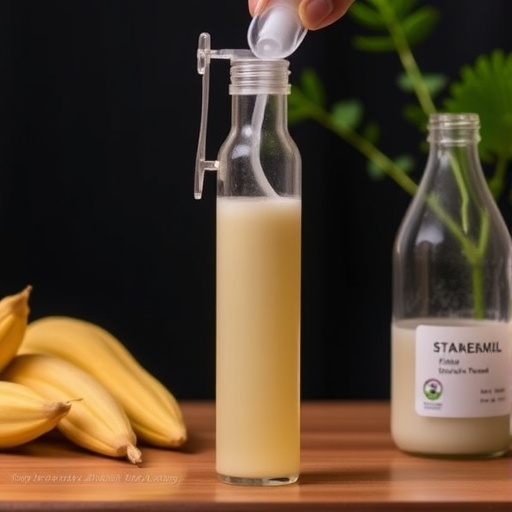In a remarkable advancement towards sustainable energy solutions, researchers have unveiled a promising method for converting cassava peel and pulp into bioethanol, an essential renewable energy source. The study, conducted by a team of scientists led by Fansuri et al., has harnessed the power of cobalt-60 gamma irradiation pretreatment to enhance glucose release from these abundant agricultural byproducts. This method not only maximizes resource utilization but also addresses the growing concerns surrounding waste management and energy production.
Cassava, a tropical root crop, is extensively cultivated for its edible starchy tubers. However, the waste generated from cassava processing, including peels and pulp, poses environmental challenges due to its high organic content. This waste is often discarded or burned, contributing to pollution and greenhouse gas emissions. The innovative approach developed by the researchers focuses on valorizing these byproducts, converting them into a viable feedstock for bioethanol production.
The utilization of gamma irradiation represents a significant breakthrough in optimizing the biochemical properties of cassava waste. By exposing the peel and pulp to cobalt-60 gamma rays, the researchers effectively altered the molecular structure of the lignocellulosic material. This pretreatment process enhances the accessibility of cellulose and hemicellulose, the primary components responsible for glucose release during fermentation. As a result, the subsequent enzymatic hydrolysis process yields a higher concentration of fermentable sugars.
The findings indicate that the gamma irradiation pretreatment notably increases the efficiency of glucose extraction from cassava waste. The researchers reported a substantial improvement in the yield of glucose when compared to untreated samples. This enhanced glucose release is crucial for the fermentation process, wherein microorganisms convert sugars into bioethanol. Consequently, the study proposes a novel pathway for producing bioethanol, leveraging agricultural waste while simultaneously reducing environmental impact.
In addition to maximizing glucose yield, the research team conducted extensive evaluations to optimize the irradiation conditions. Parameters such as radiation dose, exposure time, and moisture content were meticulously analyzed to determine their effects on the biochemical composition of cassava waste. These optimizations ensure that the pretreatment process is both effective and economically viable for large-scale applications.
Moreover, the research highlights the potential economic advantages of utilizing cassava waste as a feedstock for bioethanol production. By transforming what is typically regarded as waste into a valuable energy source, this method presents a dual benefit: it mitigates waste management issues and provides an alternative to fossil fuels. The bioethanol produced from cassava waste can be utilized as a renewable energy source for various applications, including transportation fuels and electricity generation.
The implications of this research extend beyond the immediate benefits of bioethanol production. The process of valorizing agricultural waste has sustainable development implications, aligning with global initiatives aimed at reducing waste and promoting renewable energy sources. Implementing such innovations can contribute to food security by ensuring that agricultural resources are utilized efficiently, reducing the burden on landfills and minimizing environmental degradation.
In the context of rising concerns over climate change and energy scarcity, the valorization of cassava waste through gamma irradiation presents a sustainable solution to two interconnected global challenges: waste management and renewable energy production. The approach exemplifies how scientific innovation can facilitate the transition to cleaner energy alternatives, advancing society toward a more sustainable future.
Furthermore, the research offers an essential framework for similar applications beyond cassava. Agricultural waste from other crops could also be subjected to gamma irradiation, unlocking new potential for energy production while managing waste effectively. This versatility underscores the prospect of a broader impact, enhancing biofuel production capabilities across various agricultural sectors.
As the world continues to grapple with energy demands and environmental issues, research initiatives such as this demonstrate the vital role of science and innovation. The successful application of gamma irradiation may inspire further studies aimed at improving renewable energy technologies and waste utilization strategies.
The journey toward a circular economy—where waste is repurposed and reused—requires ongoing collaboration between researchers, policymakers, and industries. By adopting innovative approaches like gamma irradiation pretreatment, stakeholders can work together to create sustainable systems that benefit both the environment and local communities.
Looking forward, it is imperative for further research to explore the scalability of this method and its integration into existing bioethanol production frameworks. The findings from Fansuri et al. provide a solid foundation for future studies aimed at optimizing agricultural waste valorization techniques, ultimately contributing to the global effort to combat climate change and promote sustainable practices.
In conclusion, the groundbreaking work surrounding the valorization of cassava peel and pulp through gamma irradiation pretreatment opens new doors for bioethanol production. By maximizing the use of agricultural waste, the study not only enhances energy sustainability but also serves as a critical stepping stone toward a circular economy. The possibilities are vast, and as research continues to unfold, the path toward renewable energy and sustainable waste management becomes increasingly promising.
Subject of Research: Valorization of cassava peel and pulp for bioethanol production through gamma irradiation pretreatment.
Article Title: Valorization of Cassava Peel and Pulp Through ^60Co-γ Irradiation Pretreatment for Enhanced Glucose Release and Bioethanol Production.
Article References:
Fansuri, H., Hidayah, R.N., Aisyah, R.N. et al. Valorization of Cassava Peel and Pulp Through 60Co-γ Irradiation Pretreatment for Enhanced Glucose Release and Bioethanol Production.
Waste Biomass Valor (2025). https://doi.org/10.1007/s12649-025-03392-z
Image Credits: AI Generated
DOI: https://doi.org/10.1007/s12649-025-03392-z
Keywords: Bioethanol, cassava waste, gamma irradiation, renewable energy, sustainable practices.
Tags: bioethanol production from cassavacassava waste managementcobalt-60 gamma rays applicationenvironmental impact of cassava wastefermentation process improvementgamma irradiation pretreatmentglucose release enhancementlignocellulosic material optimizationrenewable energy sourcessustainable agriculture innovationssustainable energy solutionsvalorization of agricultural byproducts





